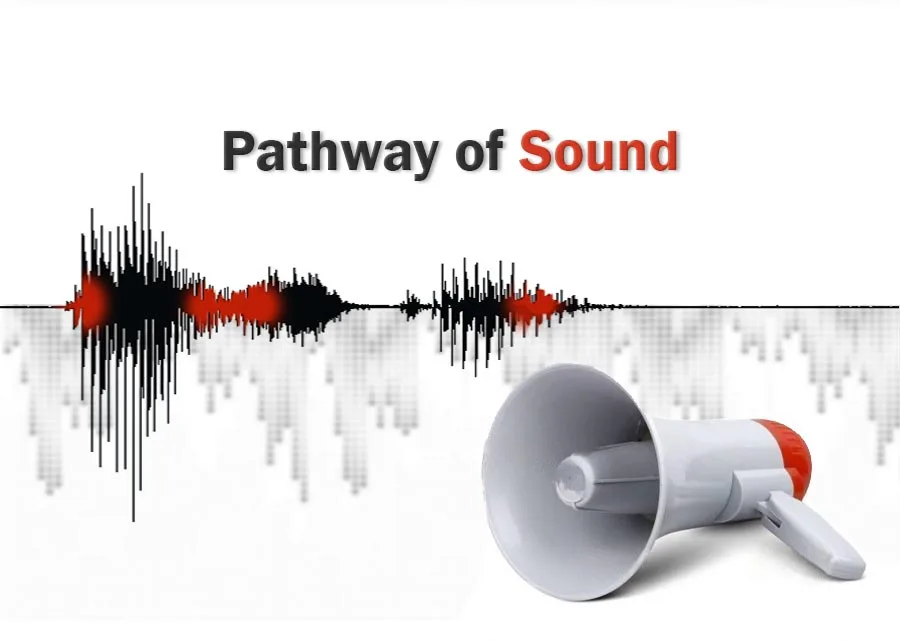The yellow arrows indicate the pathway of sound from the ear to the brain. The small middle ear bones transmit sound from the external auditory canal to the cochlea, which picks sounds depending on frequency. However, From the cochlea, the important vestibulocochlear nerve sends the signal to the brainstem. It is necessary for the auditory cortex to travel through the brain and decode the sound signal along the way before it can interpret it.
Pathway of Sound Labels
1: Tympanic membrane
2: Ossicular bones
3: Cochlea
4: Vestibulocochlear nerve
5: Cochlear nucleus
6: Superior olivary nucleus
7: Lateral lemniscus
8: Inferior colliculus
9: Medial geniculate body
10: Temporal lobe
11: Receiving enter figure modified
The auditory strategy gathers the sound waves from the surrounding environment. Then it sends mechanical vibrations from those sound waves into electrical nerve stimulations. Additionally, it may deliver to various regions of the central nervous system and interpret sound into meaningful information.
The auditory processing is the complexity, and it delivers sound to the auditory system’s capability. It also shows you localize, assess, and interpret a sound.Therefore this sound gathers that data into significant data. The individual may respond while concurrently integrating other sensory inputs.
Before a person can hear a sound, it must reach higher-order regions of the cerebral cortex. Namely the primary auditory area, and be processed there.
Bottom-up and down signaling routes then transfer the information to other sections of the central nervous system. In addition, the cerebral cortex integrates auditory and other sensory data.
To initiate the process of complex sound interpretation and the conscious sensation of noise. It is the major auditory area that is primarily responsible for receiving sounds from peripheral auditory structures.
Structure of the Primary Auditory
Principal auditory areas of the cerebral cortex discovers bilaterally in the secular lobes. However, the primary auditory area is located in the Heschl gyrus. It is found posteriorly in the superior temporal lobe, the inner of the supratemporal plane.
This cortex is pressed along the cerebral cortex’s Sylvian fissure or lateral sulcus. Additionally, it divides the temporal lobe inferiorly from the parietal.
The frontal lobe is superior, as well as adjacent auditory areas. Since the Heschl gyrus is located deep in the superficial temporal lobe structure and inside the lateral sulcus, it is not visible when viewing the cerebral cortex from the side.
Instead, it moves in a medial-posterior direction towards the brain’s center. In addition, most individuals have a left Heschl gyrus longer than a right Heschl gyrus. Therefore, it correlates with left-hemisphere language dominance and associated physical and structural differences.
Pathway of Sound from Peripheral Structures
When the sound waves come through the air, It captures with the pinna. Then its transfer via the external auditory canal. Moreover, The tympanic membrane vibrates.
The malleus, incus, and stapes, three middle ear ossicles, convert the vibration of the tympanic membrane into movement and vibration. However, it is hereafter transferred to the oval window of the internal ear.
When vibrations go on to the cochlea, the inner and outer hair cells transform the mechanical energy in vibrating sound waves into electrical energy supplied through the auditory nerve and detect them.
The cochlear nucleus finds between the pons and the medulla in the brainstem. It receives the signal from the auditory nerve. However, The signal then travels down the lateral lemniscus pathway to the medial geniculate nucleus of the thalamus. Additionally, the midbrain’s inferior colliculus and the pons’ superior olivary nucleus before synapsing in the primary auditory cortex.
During this voyage, information decussates or crosses to the other side of the brainstem. The majority of fibers from each ear take a contralateral path, creating both ipsilateral. It is contralateral information that benefits with sound localization and interpretation.
The sound will reach both ears simultaneously if it stems from the exact middle of the person. Moreover, the person’s head functions as an acoustic shadow to minimize the noise perceive in the far ear if the sound generates from one side of the person’s midline.
The sound will reach the ear closer to the other ear and it will be louder. Additionally, the ascending input channels that the peripheral system supplies to the primary auditory cortex, both descending and output pathways. Moreover, it connects the cerebral cortices to the brainstem nuclei.
This top-down signaling channel from the cerebral cortex permits the regulation of peripheral structures that respond to an individual’s attention. The significance of the auditory stimulation defines the individual’s response to sound.
Higher Processing
To the brain, Inner hair cells provide the bulk of auditory information. By synapsing with around ten additional neurons, each inner hair cell gets information from approximately ninety percent of the afferent neurons. Additionally, Each neuron innervates many hair cells, and only 10% of afferent neurons are connected to outer hair cells. In the temporal lobe, The primary auditory cortex is situated.







